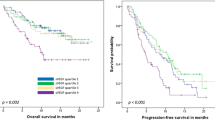Background:
Tissue hypoxia is a major stimulus for the up-regulation of vascular endothelial growth factor (VEGF). Anemia might theoretically impact on angiogenesis via impairment of tissue oxygenation. We have investigated this hypothesis in patients with solid cancers and benign diseases.
Patients and Methods: 49 patients with untreated locoregionally confined solid cancers of the head and neck, cervix, rectum and lung and 59 additional patients with non-malignant diseases (36 normemic patients without serious diseases and 23 patients with renal anemia) were enrolled and the impact of anemia on plasma VEGF levels were determined. VEGF was measured with a commercially available sandwich enzyme immunoassay technique.
Results: Plasma levels of VEGF were 16.2±12.7 pg/ml in 36 normemic patients without malignant disease, 49.2±34.5 pg/ml in 49 patients with cancers (p<0.001), and 89.9±67.8 pg/ml in 23 patients with renal anemia (p=0.001). VEGF levels in cancer patients were significantly correlated with hemoglobin (hb) levels and platelet counts (each p=0.001), but not with type of tumor, stage, histology or age. Patients with cancers had higher plasma levels of VEGF than patients with non-malignant diseases in case of hb≥12 g/dl (33.1±17.5 vs 16.6±13.0 pg/ml, p<0.001) and in case of hb between 11.0 and 11.9 g/dl (56.1±26.4 vs 18.5±14.5 pg/ml, p=0.038). In case of a hb<11 g/dl, plasma VEGF levels were significantly elevated in patients with and without cancers (67.0±47.5 vs 88.9±68.8 pg/ml, n.s.). In a multivariate model, a signifiant association between low hb levels and increased plasma levels of VEGF was confirmed. In 16 patients with renal anemia, changes in hb under erythropoietin treatment were inversely correlated with changes in plasma VEGF levels with decreasing VEGF after increase in hb (p=0.01).
Conclusions: Anemic patients have elevated levels of VEGF. The data suggest than anemia might impact on the progression of angeiogenesis in malignant and benign diseases.
Hintergrund:
Gewebehypoxie ist ein wichtiger Stimulus für die Hochregulierung des Vascular Endothelial Growth Factor (VEGF), einem Schlüsselzytokin der Angiogenese. Eine Anämie kann die Tumorhypoxie verstärken. Wir haben deshalb die Hypothese geprüft, ob eine Anämie (über die Verstärkung von Hypoxie) mit verstärkter Angiogenese assoziiert ist.
Patienten und Methodik: 49 Patienten mit unbehandelten, lokoregionär begrenzten Tumoren der Kopf-Hals-Region, der Zervix, des Rektums und der Lunge gingen in die Untersuchung ein, außerdem als Kontrolle 59 Patienten ohne maligne Erkrankungen (36 normämische Patienten aus einer Allgemeinpraxis und 23 Patienten mit renaler Anämie). Bei diesen Patienten wurde der Plasmaspiegel von VEGF mittels einer kommerziell erhältlichen Sandwich-Enzym-Immunoassays gemessen.
Ergebnisse: Die VEGF-Plasmaspiegel betrugen 16,2±12,7 pg/ml bei 36 normämischen Patienten ohne Tumoren, 49,2±34,5 pg/ml bei 49 Patienten mit Tumoren (p<0,001) und 89,9±67,8 pg/ml bei 23 Patienten mit renaler Anämie (p=0,001). Es fand sich eine signifikante Korrelation der VEGF-Spiegel mit dem Hämoglobin-(Hb-) und den Thrombozytenwerten (jeweils p=0,001). Dagegen bestand kein Zusammenhang zwischen VEGF und Tumorstadium, Alter oder Tumorlokalisation. Tumorpatienten hatten im Vergleich zu Patienten ohne Tumoren signifikant erhöhte VEGF-Spiegel, wenn der Hb-Wert≥12 g/dl war (33,1±17,5 vs. 16,6±13,0 pg/ml, p<0,001) und bei einem Hb-Wert zwischen 11,0 und 11,9 g/dl (56,1±26,4 vs. 18,5±14,5 pg/ml, p=0,038). Bei anämischen Patienten mit einem Hb<11 g/dl waren die Plasma-VEGF-Spiegel in beiden Gruppen signifikant erhöht und nicht verschieden voneinander (67,0±47,5 vs. 88,9±68,8 pg/ml, n.s.). Der Zusammenhang zwischen Hb-Wert und VEGF-Spiegel wurde in einem multivariaten Modell bestätigt. Bei 16 Patienten mit renaler Anämie wurden Verlaufsmessungen des VEGF-Spiegels unter Behandlung von Erythropoietin durchgeführt; dabei fand sich ein signifikanter Zusammenhang mit dem Abfall des erhöhten VEGF bei Anstieg des Hb-Wertes (p=0,01).
Schlussfolgerungen: Anämische Patienten haben erhöhte systemische Konzentrationen von VEGF. Dies bedeutet auf einen eigenständigen Einfluss der Anämie auf Angiogenese hin.
Similar content being viewed by others
Author information
Authors and Affiliations
Additional information
Received: August 10, 2001; accepted: June 11, 2002
Rights and permissions
About this article
Cite this article
Dunst, J., Becker, A., Lautenschläger, C. et al. Anemia and Elevated Systemic Levels of Vascular Endothelial Growth Factor (VEGF). Strahlenther Onkol 178, 436–441 (2002). https://doi.org/10.1007/s00066-002-0925-8
Issue Date:
DOI: https://doi.org/10.1007/s00066-002-0925-8




